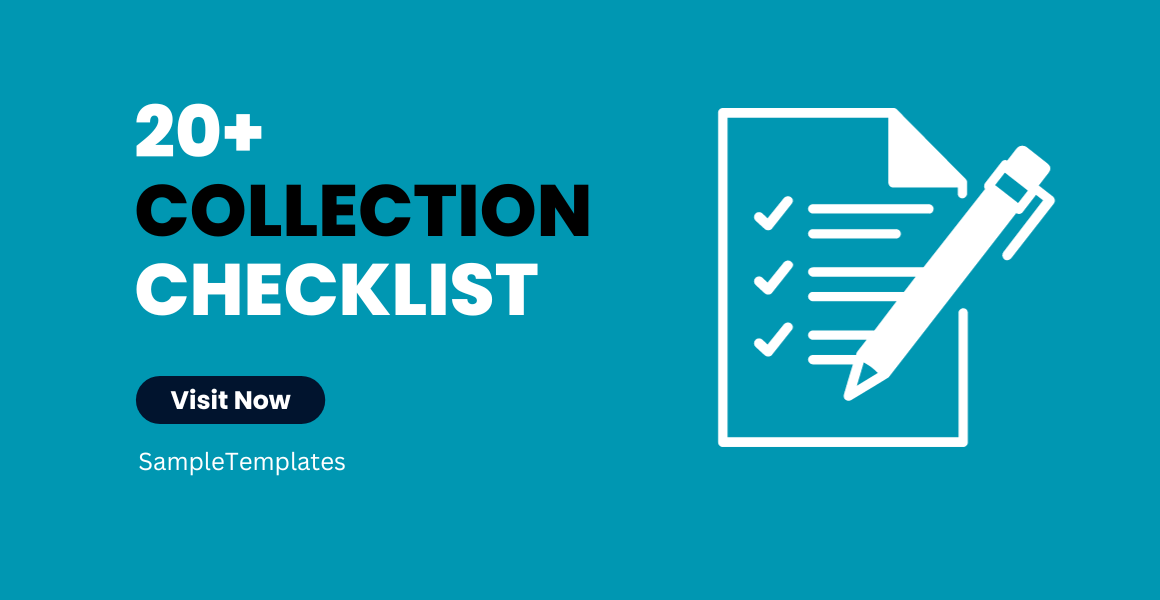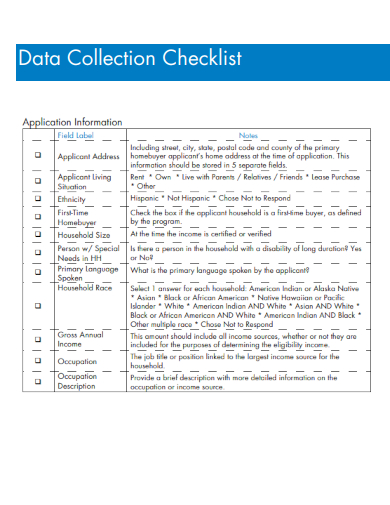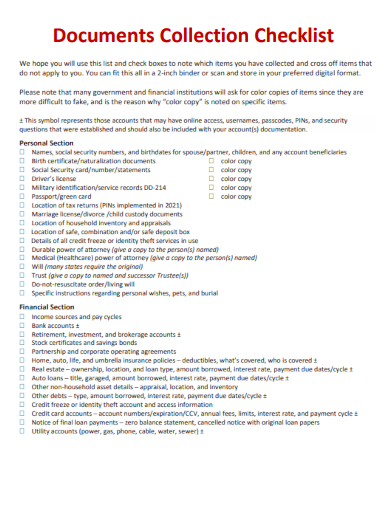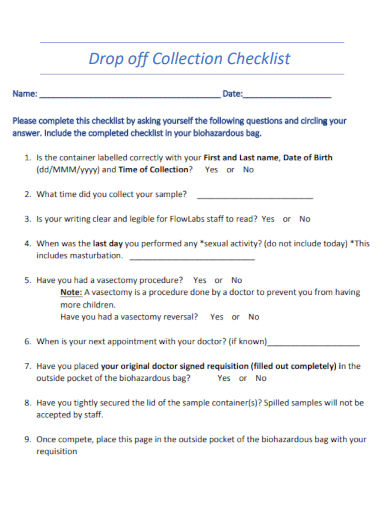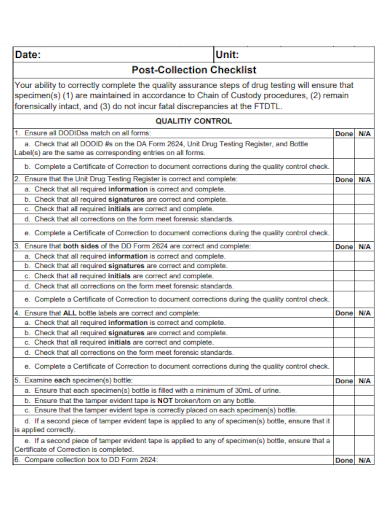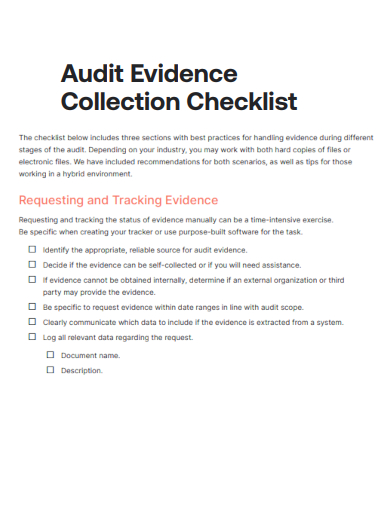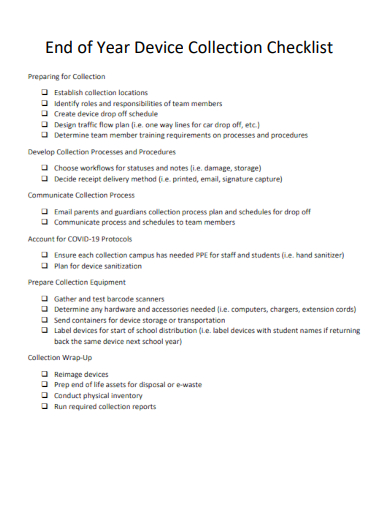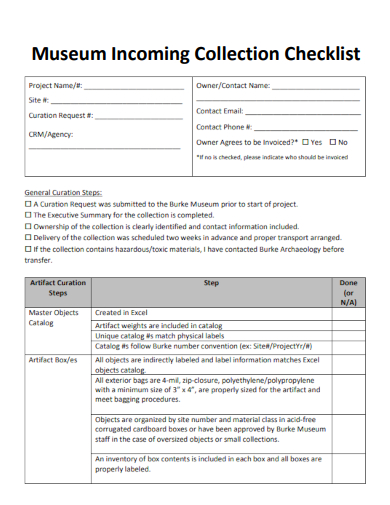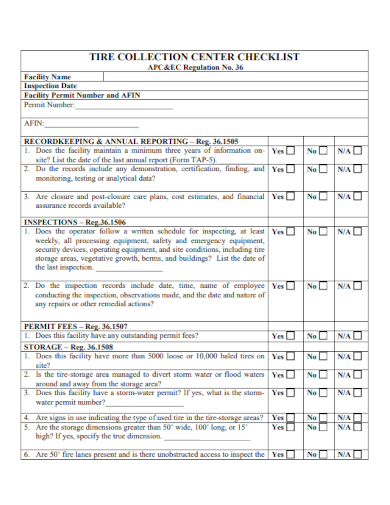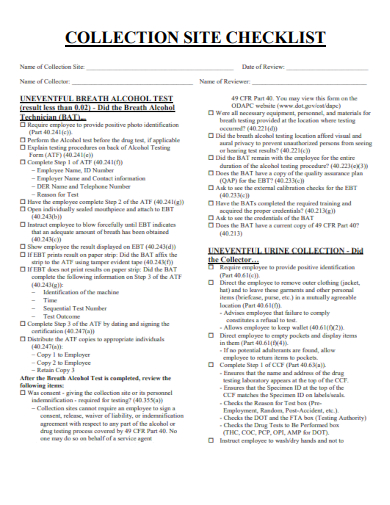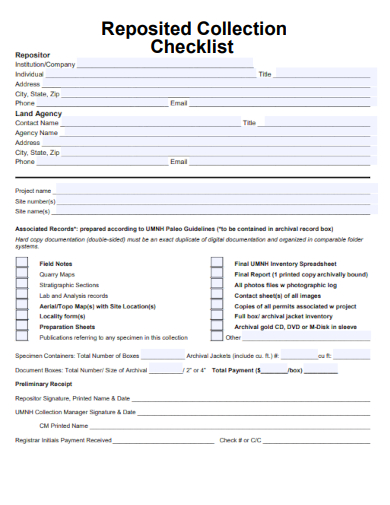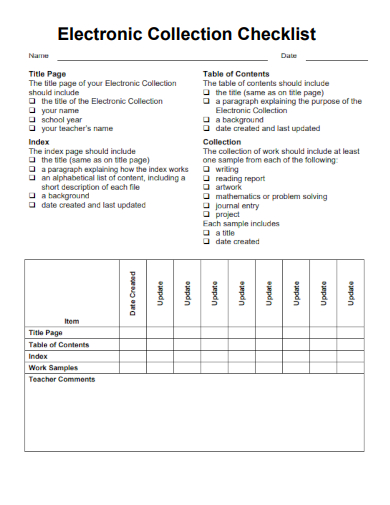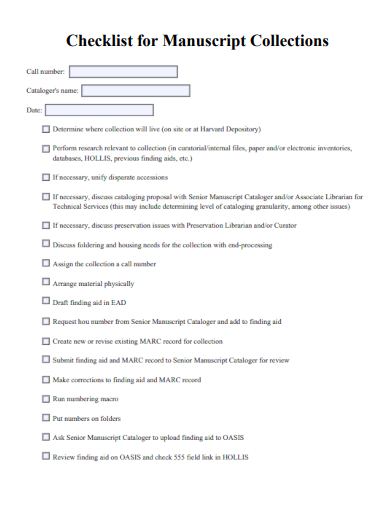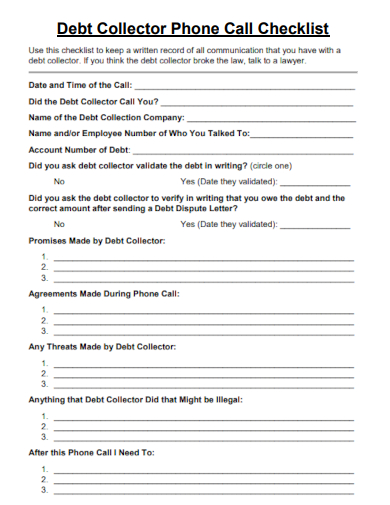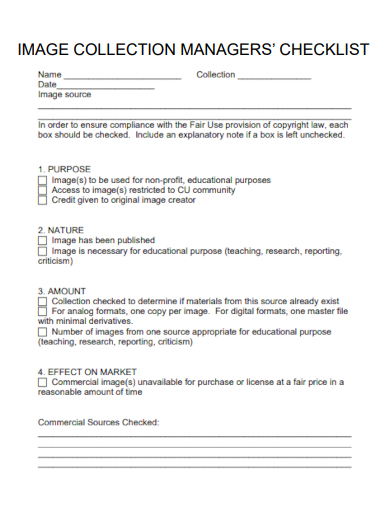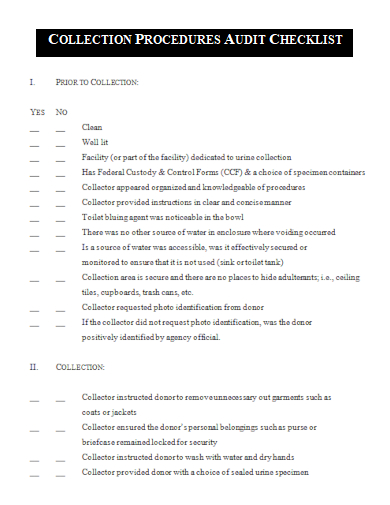In today’s fast-paced world, managing and organizing collections has become paramount. Whether you’re a hobbyist or a seasoned collector, having a comprehensive Collection Checklist can be a game-changer. This guide offers insights and tools to streamline your collecting process, ensuring that no item goes unnoticed. Dive in to discover the ultimate strategy to optimize your collection management, making it efficient, organized, and most importantly, enjoyable. Let your passion shine with an orderly approach.
FREE 20+ Collection Checklist Samples
1. Sample Collection Checklist Template

2. School Library Collection Maintenance Checklist
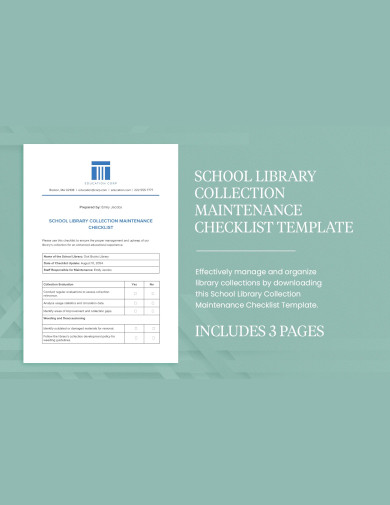
3. Basic Checklist Template
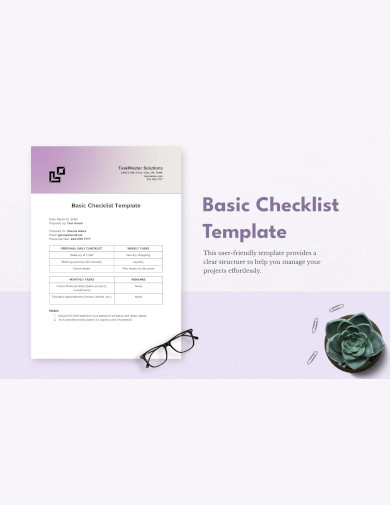
4. Formal Checklist Template
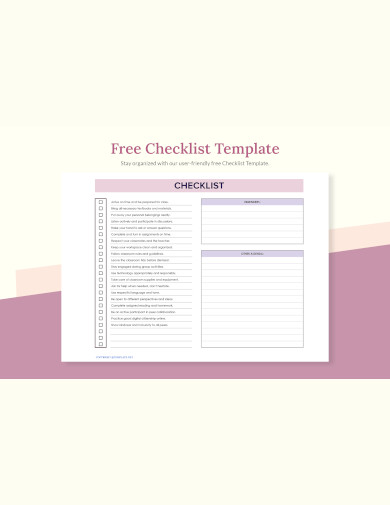
5. Printable Checklist Template
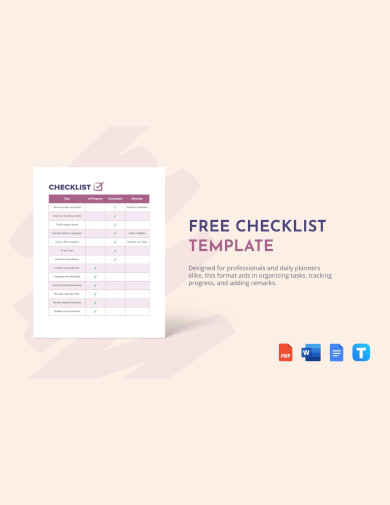
What is a Collection Checklist?
A Collection Checklist is essentially an organized sample list or system used to track and manage a set of items, tasks, or information. While checklists, in general, have been around for centuries, the term ‘Collection Checklist’ has become particularly popular among hobbyists, professionals, and collectors of all kinds. It ensures that no item or task is overlooked and offers a structured view of the overall collection or set of tasks at hand.
Why the Need for a Collection Checklist?
- Ensuring Completeness: Whether you’re collecting stamps, coins, or embarking on a series of tasks for a project, a checklist ensures that every item or task is accounted for. It acts as a safeguard against human memory lapses or oversights.
- Monitoring Progress: For collectors, knowing which items are already acquired and which ones are still pending provides a sense of accomplishment. Similarly, for projects, knowing which tasks have been completed gives a clear view of progress.
- Priority Setting: Not all items in a collection or tasks in a project hold equal importance. With a collection checklist, you can prioritize based on rarity, urgency, or any other criteria that fits the scenario.
Real-Life Applications of Collection Checklists
- Hobbies & Collectibles: From comic books to vintage cars, collectors use checklists to ensure they have every piece they desire and to keep track of items’ conditions, acquisition dates, and more.
- Project Management: In the corporate world, project managers often use checklists to keep track of various project stages, deliverables, and milestones.
- Digital Assets Management: In the realm of digital marketing and content creation, collection checklists help in organizing and tracking various assets like images, videos, and articles.
- Event Planning: Be it a wedding, corporate event, or a community gathering, event planners use checklists to ensure every aspect of the event, from food to entertainment, is taken care of.
Maximizing the Potential of Your Collection Checklist
To harness the full potential of a collection checklist:
- Regularly Update: As new items are added or tasks are completed, update the printable list. This not only ensures accuracy but also offers a real-time view of your progress.
- Stay Digital: While traditional pen-and-paper checklists have their charm, digital checklists, especially those with cloud capabilities, can be accessed and updated from anywhere, ensuring you always have the latest version at your fingertips.
- Share and Collaborate: If your collection or project involves multiple stakeholders, consider sharing the checklist. Collaboration ensures collective progress and input.
What are the Types of Collection Checklist?
Certainly! Collection checklists can be broadly categorized based on their usage and the nature of the items being collected. Here are some common types:
- Inventory Collection Checklist: Used by businesses to keep track of their stock, ensuring they have all the necessary items available and accounted for.
- Data Collection Checklist: Utilized in research and surveys to ensure that all necessary data points and metrics are consistently gathered.
- Task Collection Checklist: Common in project management, this type helps teams track and ensure completion of all necessary tasks or milestones within a project.
- Collectibles Checklist: Used by hobbyists and collectors for items like stamps, coins, toys, or cards. It helps them identify what they already have and what’s still missing.
- Event Planning Checklist: For organizing events, ensuring that all aspects, from venue booking to catering, are considered and executed.
- Digital Assets Collection Checklist: Used in the digital realm to keep track of and manage assets like images, videos, software, and content pieces.
- Safety and Compliance Checklist: Employed in sectors like construction or manufacturing to ensure all safety measures and regulatory standards are met.
- Travel Collection Checklist: For travelers to ensure they’ve packed everything they need, have all essential design documents, and have completed necessary pre-travel tasks.
- Document Collection Checklist: Often used in legal, financial, or administrative settings, this ensures that all required documents and forms are collected, signed, and processed.
- Onboarding Checklist: In businesses, for ensuring that new employees receive, understand, and complete all necessary printave forms, trainings, and introductions.
6. Sample Data Collection Checklist Template
7. Sample Documents Collection Checklist Template
8. Sample Drop Off Collection Checklist Template
9. Sample Post Collection Checklist Template
10. Sample Audit Evidence Collection Checklist Template
11. Sample End of Year Device Collection Checklist Template
12. Sample Museum Incoming Collection Checklist Template
13. Sample Payroll Overpayment Collection Checklist Template
14. Sample Collection Center Checklist Template
15. Sample Collection Site Checklist Template
16. Sample Reposited Collection Checklist Template
17. Sample Electronic Collection Checklist Template
18. Sample Checklist for Manuscript Collections Template
19. Sample Debt Collector Phone Call Checklist Template
20. Sample Image Collection Manager Checklist Template
21. Sample Collection Procedure Audit Checklist Template
How do you Create a Collection Checklist?
A collection checklist is essential for avid collectors, whether you’re gathering rare coins, vintage stamps, or contemporary art pieces. Having a comprehensive checklist ensures that you’re always aware of what you have, what you’re seeking, and what might be available. Let’s delve into a simplified 5-step guide on creating an effective collection checklist.
Step 1: Define Your Collection’s Scope and Theme
Every collection has a unique outline story, whether it’s motivated by passion, history, aesthetics, or investment. Start by defining the scope and theme of your collection. For instance, if you’re collecting vintage stamps, are they from a particular era, country, or theme? Clearly outlining your collection’s scope helps refine and focus your acquisition efforts.
Step 2: Research and Document Existing Items
Begin by documenting all the items you already possess. This can be a straightforward list or a detailed catalog, noting specifics like acquisition date, origin, condition, and any provenance details. By knowing what you already have, you can prevent accidental duplicate purchases and see gaps in your collection.
Step 3: Identify Desired Items
Based on your defined scope and theme, list down the items you aim to acquire. For a stamp collector, this might include specific stamps from rare print runs or specific historical periods. Use catalogs, online forums, and collector communities as resources to ensure your list is exhaustive. This “wish list” acts as a motivational tool and a sample roadmap for future acquisitions.
Step 4: Create a Budget and Set Priorities
Collections can range from budget-friendly hobbies to high-end investments. Define a budget for your collection and stick to it. Within this budget, prioritize your desired items. Rare or one-of-a-kind items might be worth allocating a larger portion of your budget, while more common items can be acquired over time. This prioritization ensures that your spending aligns with the importance of each item to your collection.
Step 5: Track and Update Regularly
A collection is a dynamic entity; it grows, changes, and evolves. Regularly update your checklist with new acquisitions, potential sales, or trades. Additionally, as market availability and your personal preferences change, adjust your desired items list. An updated checklist ensures that your collection remains organized and you always have a clear picture of its status.
What is Checklist for Data Collection?
A Checklist for Data Collection is a structured list used to ensure that all necessary data points and aspects are gathered systematically and consistently. It aids researchers, analysts, and professionals in avoiding oversights, ensuring accuracy, and facilitating thorough data acquisition for subsequent analysis or use.
In conclusion, a Collection Checklist is more than just a list. It’s a dynamic tool that brings organization, clarity, and efficiency to our endeavors, whether they’re rooted in passion, profession, or personal projects. As with any tool, its true power lies in how we choose to wield it.
Related Posts
FREE 18+ Facilitator Checklist Samples in MS Word | Google Sheets | PDF
FREE 18+ Complaint Checklist Samples in MS Word | Google Sheets | PDF
FREE 18+ Internship Checklist Samples in MS Word | Google Docs | PDF
FREE 18+ Statement Checklist Samples in MS Word | Google Sheets | PDF
FREE 20+ Voluntary Checklist Samples in MS Word | Google Sheets | PDF
FREE 18+ Summary Checklist Samples in MS Word | Google Sheets | PDF
FREE 14+ Sponsorship Checklist Samples in MS Word | MS Excel | PDF
FREE 18+ Conference Checklist Samples in MS Word | Google Sheets | PDF
FREE 17+ Lesson Checklist Samples in MS Word | Google Sheets | PDF
FREE 18+ Progress Checklist Samples in MS Word | Google Docs | PDF
FREE 18+ Enrollment Checklist Samples in MS Word | Google Docs | PDF
FREE 18+ Graduation Checklist Samples in MS Word | Google Sheets | PDF
FREE 15+ Consent Checklist Samples in MS Word | Google Sheets | PDF
FREE 18+ Submission Checklist Samples in MS Word | Google Docs | PDF
FREE 18+ Request Checklist Samples in MS Word | MS Excel | PDF
